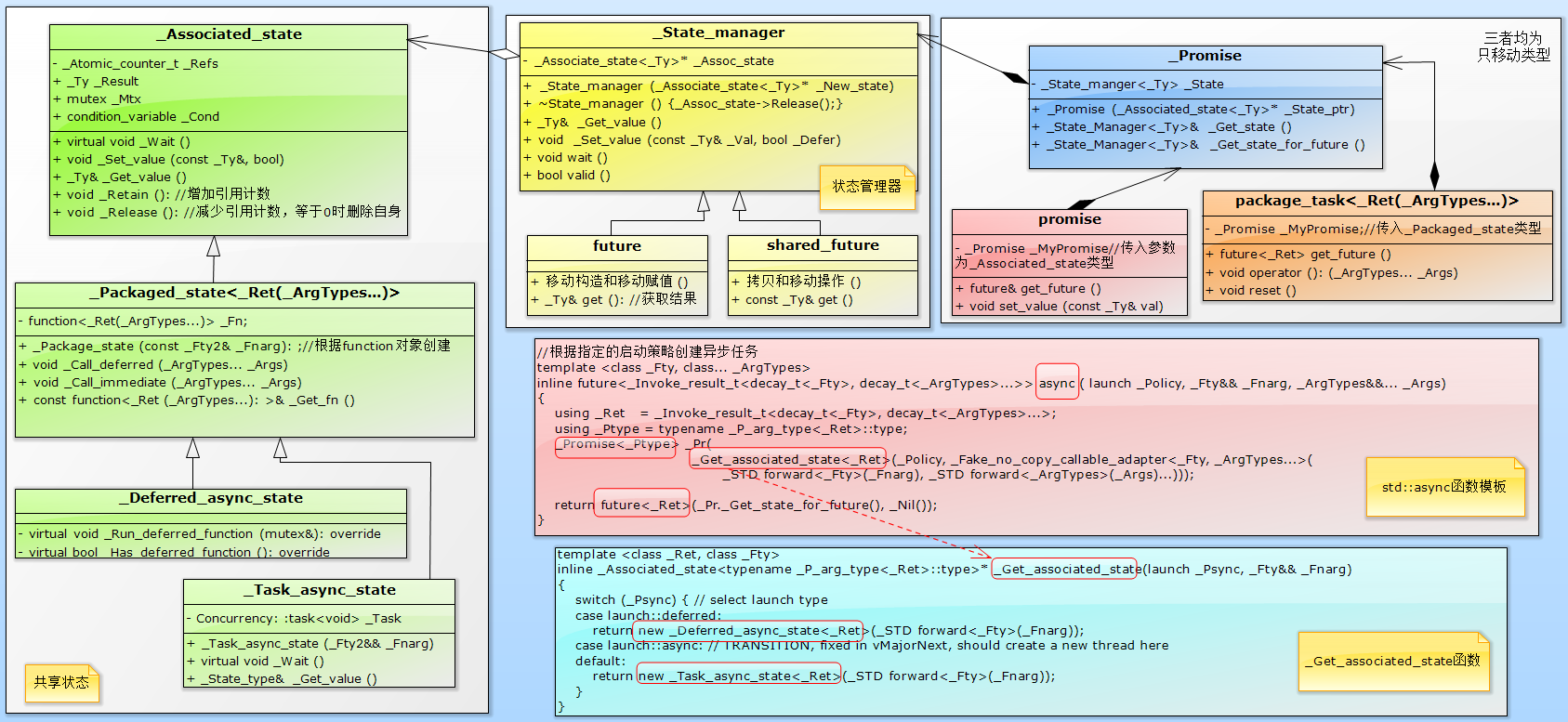一. std::async函数模板
(一)std::async和std::thread的区别
1. 两者最明显的区别在于async采用默认启动策略时并不一定创建新的线程。如果系统资源紧张,那么std::thread创建线程可能失败,系统报告异常,整个程序可能崩溃。而std::async一般则不会,它在无法创建新线程时,会将任务分配给后续调用future.get()函数的线程,并以同步的方式执行(即不创建新线程)。
2. std::async表现为更高阶的抽象,它把用户从线程管理的细节解放出来,将这些责任转交给C++标准库的实现者。而std::thread要求自行处理线程耗尽、超订、负载均衡以及新平台适配问题。
3. std::thread未提供直接获取线程函数返回值的方法。但std::async可以通过future对象来获取。
(二)std::async函数模板及分析

1. “共享状态”对象,用于保存线程函数(一般是可调用对象)及其参数、返回值以及新线程状态等信息。该对象保存在堆中,由std::async、std::promise或std::package_task提供,并交由future或shared_future管理其生命期。被调方(通常指调用promise.set_value()的一方)将计算所得的结果写入“共享状态”,而调用方通过std::future的get()读取该结果。

2. 调用std::async是会创建一个“_Deferred_async_state”或_“Task_async_state”类的“共享状态”对象,该对象是_Packaged_state的子类。注意,直接创建std::promise时,生成的是“_associated_state”类的共享状态对象,而std::package_task创建的是“_Packaged_state”类的共享状态对象。
3. _Get_associated_state是个工厂函数,通过不同的策略创建不同的“共享状态”对象,并将其交由future管理,负责其生命周期。future类似于std::unique_ptr,对“共享状态”对象“独占”所有权。
4. 与std::thread一样,传入std::async中的可调用对象及其参数会被按值以副本形成保存成一个tuple对象,然后再以右值的方式传入线程函数中对应的参数。
【编程实验】创建异步任务
#include <iostream> #include <thread> #include <future> #include <mutex> #include <vector> #include <numeric> //for std::accumulate using namespace std; std::mutex mtx; class Widget { public: void foo(int x, const std::string& s) { std::lock_guard<std::mutex> lk(mtx); cout << "thread id = "<<std::this_thread::get_id()<< " void Foo::foo(int, const std::string&): x = " << x << ", s = " << s<< endl; } void bar(const std::string& s) { std::lock_guard<std::mutex> lk(mtx); cout << "thread id = " << std::this_thread::get_id() <<" void Widget::bar(const std::string&): s = " << s << endl; } void operator()(double val) { std::lock_guard<std::mutex> lk(mtx); cout << "thread id = " << std::this_thread::get_id() << " void Widget::operator(): val = " << val << endl; } }; class NonCopyable //只移动对象 { public: NonCopyable() {}; NonCopyable(const NonCopyable&) = delete; NonCopyable& operator=(const NonCopyable&) = delete; NonCopyable(NonCopyable&&) = default; NonCopyable& operator=(NonCopyable&&) = default; double operator()(double d) { std::lock_guard<std::mutex> lk(mtx); cout << "thread id = " << std::this_thread::get_id() << " void NonCopyable::operator(): d = " << d << endl; return d; } }; //并行计算 template<typename RandomIt> int parallel_sum(RandomIt beg, RandomIt end) { auto len = end - beg; if (len < 1000) { std::lock_guard<std::mutex> lk(mtx); cout << "thread id = " << std::this_thread::get_id() << " invoke parallel_sum()" << endl; return std::accumulate(beg, end, 0); //遍历[beg,end)区别的每个元素并累加。初始值为0 } RandomIt mid = beg + len / 2; auto handle = std::async(std::launch::async, //子线程将[mid,end)元素进行累加 parallel_sum<RandomIt>, mid, end); int sum = parallel_sum(beg, mid);//本线程将[begin,mid)区间元素进行累加 return sum + handle.get(); //返回两个区间结果的累加和 } int main() { Widget w; cout << "main thread id = " << std::this_thread::get_id() << endl; //1. 参数传递 auto fut1 = std::async(&Widget::foo, &w, 42, "hello"); //传入this指针:&w auto fut2 = std::async(&Widget::bar, w, "goodbye"); //传入x的副本如tmp。 tmp.bar(...) auto fut3 = std::async(Widget(), 3.14159); //传入Widget临时对象,调用operator() auto fut4 = std::async(std::ref(w), 2.718); //传入w的引用,调用operator(); NonCopyable mo; //只移动对象 auto fut5 = std::async(std::move(mo),3.14159); //mo是只移动对象,必须被转为右值 //2. 同步、异步 auto fut6 = std::async(std::launch::async, Widget(), 1.2); //在新线程上运行,operator() auto fut7 = std::async(std::launch::deferred, &Widget::bar, &w, "deferred"); //线程延迟到调用get或wait才执行 auto fut8 = std::async(std::launch::async | std::launch::deferred, //等价于默认启动策略 &Widget::bar, &w, "async | deferred"); fut7.get(); //主线程阻塞,等待fut7子线程。(子线程延迟到这时才执行)。 //3. 并行计算 std::vector<int> vec(10000, 1); //10000个1 int res = parallel_sum(vec.begin(), vec.end()); { std::lock_guard<std::mutex> lk(mtx); cout << "The sum is: " << res << endl; cout << "main thread end." << endl; } return 0; } /*输出结果 main thread id = 16756 thread id = 1928 void Foo::foo(int, const std::string&): x = 42, s = hello thread id = 16756 void Widget::bar(const std::string&): s = deferred //注意,由主线程执行 thread id = 13216 void Widget::bar(const std::string&): s = goodbye thread id = 7940 void Widget::operator(): val = 3.14159 thread id = 16080 void Widget::operator(): val = 2.718 thread id = 11492 void NonCopyable::operator(): d = 3.14159 thread id = 1928 void Widget::operator(): val = 1.2 thread id = 13216 void Widget::bar(const std::string&): s = async | deferred thread id = 16756 invoke parallel_sum() thread id = 7940 invoke parallel_sum() thread id = 16080 invoke parallel_sum() thread id = 11492 invoke parallel_sum() thread id = 1928 invoke parallel_sum() thread id = 13216 invoke parallel_sum() thread id = 1928 invoke parallel_sum() thread id = 7636 invoke parallel_sum() thread id = 5816 invoke parallel_sum() thread id = 15856 invoke parallel_sum() thread id = 15832 invoke parallel_sum() thread id = 7636 invoke parallel_sum() thread id = 15400 invoke parallel_sum() thread id = 16968 invoke parallel_sum() thread id = 15856 invoke parallel_sum() thread id = 15476 invoke parallel_sum() The sum is: 10000 main thread end. */
二. std::async的启动策略
(一)std::async的启动策略
1. 三种启动策略(std::async通过指定不同的启动策略来决定创建是“共享状态”对象)
(1)异步方式(std::launch::async):会创建一个“_Task_async_state”类的共享状态对象。使用该策略时异味着线程函数必须以异步的方式运行,即在另一个线程之上执行。
(2)同步方式(std::launch::deferred):会创建一个“_Deferred_async_state”类的共享状态对象。使用该策略意味着线程函数延迟到调用future的get/wait时才得以运行,而且两者是在同一线程上以同步的方式运行。即调用future的一方会阻塞至线程函数运行结束为止。如果get/wait没有得到调用,则线程函数不会被执行。
(3)默认启动策略(std::launch::async|std::launch::deferred):即两者或运算的结果,这意味着任务可能以异步或同步的方式被运行。也就是说是否创建新线程来运行任务,取决于系统资源是否紧张,由标准库的线程管理组件承担线程创建和销毁、避免超订以及负载均衡的责任。
(二)默认启动策略
1. 带来的问题
(1)用户无法预知是异步还是同步运行,因为线程函数可能被调度为延迟执行。
(2)无法预知线程函数是否与调用future的get/wait函数线程是否在同一线程运行。如果此时线程函数会读取线程局部存储(thread_local storage, TLS),那么也就无法预知会取到哪个线程的局部存储。
(3)有时甚至连线程函数是否会运行,这件起码的事情都是无法预知的。这是因此无法保证在程序的每条路径上future的get或wait都会得以调用。
2. 注意事项:
(1)默认启动策略能正常工作需要满足以下所有条件。
①任务不需要与调用get/wait的线程并发执行。
②读/写哪个线程的thread_local变量无关紧要。
③可以保证在std::async返回的future上调用get/wait,或者可以接受任务可能永不执行。
④用户已清楚使用wait_for或wait_unitil的代码任务可能被推迟执行,这种可能性己被纳入考量。
(2)只要其中一个条件不满足,就必须手动指定启动策略以保证任务以异步或同步的方式运行。
【编程实验】默认启动策略问题的解决
#include <iostream> #include <future> using namespace std; using namespace literals; //for duration suffixes(时长后缀,如1s) void func() { std::this_thread::sleep_for(1s); } //reallyAsync函数模板:用于保证任务被异步执行 template<typename Func, typename ...Args> inline auto reallyAsync(Func&& f, Args... args) { return std::async(std::launch::async, std::forward<Func>(func), std::forward<Args>(args)...); } int main() { //wait_for函数必须可虑任务是同步或异步运行 auto fut1 = std::async(func); //默认启动策略,无法预估任务是被同步还是异步运行 //解决方案1:wait_for(0s) if (fut1.wait_for(0s) == std::future_status::deferred){ //同步运行,wait_for(0s) fut1.get(); //等待结果 }else { //异步运行 while (fut1.wait_for(100ms) != std::future_status::ready) { //轮询子线程是否结束 //... //并发做其他任务 } //... //fut is ready } //解决方案2:确实以异步运行任务 auto fut2 = reallyAsync(func); while (fut2.wait_for(100ms) != std::future_status::ready) //异步方式,确保wait_for返回ready的结果 { //从而消除future_status::deferred的可能 } return 0; }